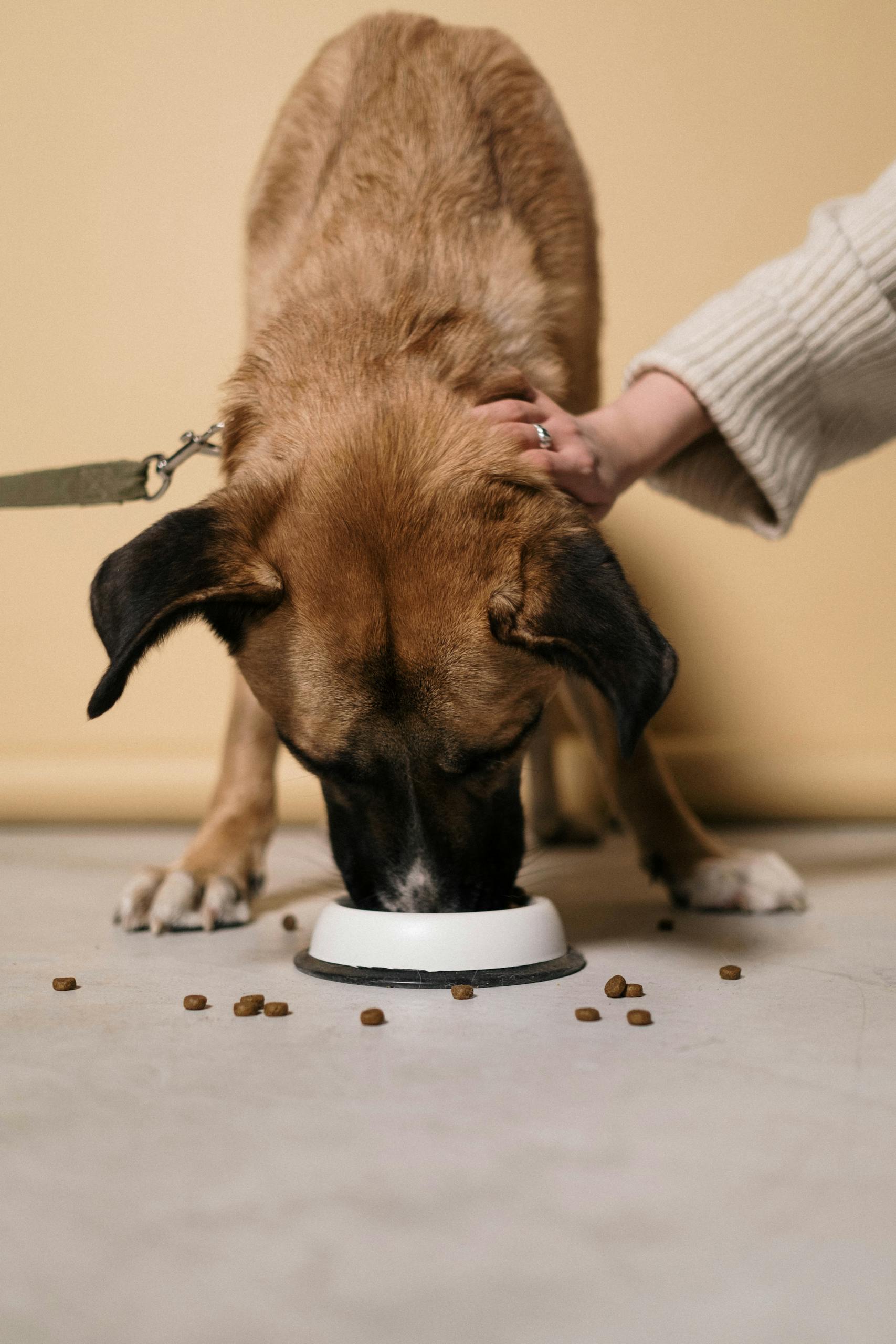The Ultimate Guide to Choosing the Best Dog Food [Updated for 2025]
The Ultimate Guide to Choosing the Best Dog Food. When I first welcomed my dog, Savannah, into my life, picking the best dog food felt overwhelming.
Every label promised something different and I wanted to make sure Savannah had meals that not only tasted good but supported her health and happiness.
As I started digging deeper, I realized how much dog breeds and even dog trainig needs can impact your choice of food.
This ultimate guide is here for both new puppy parents and seasoned owners. I’ll share what I learned on my journey, highlight the importance of quality nutrition for every breed, and give you up-to-date dog food reviews along the way.
From feeding tips to puppy nutrition guide advice and connections between food and dog obedience training, you’ll get practical info you can use right away. Whether you want to support your dog’s learning in online dog training or just want to know you’re feeding your best friend right, this guide has you covered.
Table of Contents
Key Takeaways
Choosing the best dog food for your furry friend is both a science and a personal journey. After my experience with Savannah, I’ve realized there’s no single right answer.
What matters is that you make an informed choice with trusted info, a clear understanding of your dog, and confidence in your decisions. Here are the most important things every dog owner should keep in mind.
 Photo by MART PRODUCTION
Photo by MART PRODUCTION
Every Dog is Unique
My own search with Savannah reminded me that no two dogs are the same. Size, age, and health shape their needs.
- Different dog breeds have unique dietary goals. A Dachshund may need a different meal plan than a Labrador or Akita. If you’re curious about breed-specific care, check out these Dachshund dog breed tips or interesting Akita dog facts.
- Puppies, adults and seniors have different nutritional requirements.
- Some dogs need special formulas for sensitive stomachs, allergies or joint care.
Learn to Read Labels and Reviews
Dog food reviews are a huge help, but don’t just look at ratings—read what’s inside. I always check for these:
- Whole protein sources like chicken, beef, or fish as the first ingredient.
- Minimal fillers or artificial additives.
- How to Choose the Best Dog Food by PetMD gives clear tips on spotting quality foods.
- For up-to-date insights or comparisons, Dog Food Advisor: Dog Food Reviews and Ratings breaks down ingredients and brand reputations.
Nutrition Impacts Training and Behavior
What your dog eats influences more than just their body. Diet actually links closely to dog obedience training and learning.
- Balanced nutrition can boost focus during obedience sessions and even online dog training.
- The wrong food may cause sluggishness or hyperactivity, disrupting daily routines and training efforts.
- Consistency in their diet helps support consistency in behavior—both at home and in training classes.
Keep Adapting
Your dog’s needs can shift over time, just like Savannah’s did as she grew. Stay open to updating their routine.
- Watch for changes in weight, energy or coat condition.
- Don’t hesitate to shift food types as your dog ages or if activity levels change.
- Use trusted sources for dog food reviews to help guide new choices.
Building a food routine that helps your dog thrive doesn’t end with the first bag you buy. As with dog trainig, the right diet takes patience and a willingness to learn what works best.
Why Choosing the Best Dog Food Matters
Choosing the best dog food is the single biggest way to set your dog up for a happy, healthy life. It doesn’t just fill their belly, it fuels every moment, every wag, and every training session.
Long before I started reading dog food reviews or seeing the difference they made for Savannah, I thought all kibble was alike. One look at her shiny coat and brisk energy after switching diets made it clear—a good meal is a game changer.
Nutrition and Your Dog’s Wellbeing
 Photo by cottonbro studio
Photo by cottonbro studio
Every dog breed has its own nutritional sweet spot, but some basics apply to all. Dogs need balanced amounts of protein, fats, carbohydrates, vitamins, and minerals. But not all dog food delivers this balance.
From my experience with Savannah, switching to a premium, well-reviewed food changed everything: her coat was softer, her energy more stable, and her breath fresher. I realized the impact of quality food during our daily walks and especially during dog obedience training when her attention and response soared.
Look for these when picking your food:
- Protein from real meat (chicken, beef, or fish) as the first listed ingredient.
- Healthy fats for energy and a glossy coat.
- Carbohydrates such as sweet potatoes or brown rice for endurance.
- Vitamins and minerals to support the immune system and bones.
Quality nutrition shows up in:
- Smooth, itch-free skin and a glossy coat.
- Consistent energy and playfulness.
- Solid dental health.
- Clear eyes and less shedding.
A balanced diet doesn’t just boost your dog’s body—it fuels their mind, making dog obedience training and even online dog training sessions smoother. The link between food and behavior is strong. If Savannah eats well, she’s more eager to train and learn.
If you want an expert breakdown of food labels and ingredient lists, this PetMD guide unpacks what matters most for each life stage.
Common Mistakes When Selecting Dog Food
Choosing dog food can be a minefield of marketing and myths. Over the years, I’ve seen (and made) a few mistakes—some of which kept Savannah from feeling her best until I made changes. Here are some common pitfalls to watch for:
- Choosing by price alone: Cheap bags can cut corners on protein by using too many fillers or low-nutrient byproducts. A higher price doesn’t always mean it’s the best dog food, but suspiciously cheap options often lack quality.
- Ignoring your dog’s breed and age: What works for a young, active Dalmatian is not right for a laid-back senior Pug. Always check for formulas designed for your dog’s breed size and life stage.
- Falling for flashy marketing: “Natural” or “premium” on a bag isn’t proof. Always read the ingredient list. If meat isn’t the first ingredient, it’s probably not the best choice.
- Skipping over food reviews: Real pet owner insights and expert dog food reviews reveal long-term results, not just first impressions.
- Missing special needs: If your pet has a sensitive stomach, allergies or food intolerances, general brands may worsen the problem. Savannah had itchy paws until we switched to a formula for food sensitivities.
Here’s what some owners run into:
- Buying food labeled “for all breeds” without checking if it fits their specific dog’s needs.
- Not switching formulas as a dog’s activity level or age changes—making the dog less energetic or even overweight.
- Overlooking trusted resources. Skipping sites with comprehensive breed nutrition tips, or missing articles about how nutrition supports training and growth.
Mistakes happen, but each one is a lesson. If you’re ready to see how food shapes everything from your dog’s coat to their performance in dog obedience classes, take a little extra time to read labels and reviews. Your dog will thank you, just like Savannah thanks me every time she cleans her bowl.
Key Factors to Consider When Selecting the Best Dog Food
Choosing the best dog food was a turning point in Savannah’s health and happiness. Over time, I learned that a bag’s fancy claims are never as important as what’s really inside, how well it suits my dog’s age and breed, and what other dog owners actually think. Let’s break down the factors that matter most.
Understanding Ingredients and Labels
 Photo by MART PRODUCTION
Photo by MART PRODUCTION
Decoding dog food labels isn’t just for nutrition geeks. It can tell you whether a food provides real value, or just clever marketing. When I started reading ingredients for Savannah, here’s what I learned:
- The first ingredient matters most. Look for whole protein sources (like chicken, beef, or fish) up front. Avoid brands where meat meals and byproducts top the list, since these can contain more fillers or lower-quality protein.
- Meat meals vs. byproducts: Meat meal means the moisture is removed, making it a concentrated protein source. Byproducts are the leftovers (think organs or bones) not always bad, but lower on the quality spectrum when unlisted or vaguely named.
- Grains have a place. Some dogs digest grains like rice or oats well, while others need grain-free. Not all grains are “fillers”—many are healthy carbs. It’s about what works for your dog.
A solid overview of reading and interpreting labels is found in A Guide to Dog Food Ingredients and Reading Labels. For legal definitions and labeling practices, check out AAFCO’s Reading Labels. These guides will boost your confidence and help you avoid surprises on your next shopping trip.
Tailoring Nutrition for Breed and Age
No two dogs eat alike. Savannah’s food as a puppy would never be her best meal today. Growing puppies, couch-loving seniors, and high-energy breeds all need special consideration.
- Puppies: Need extra calories, protein, and healthy fats for growth and learning. Curious how to get this right? Our detailed puppy nutrition guide covers everything from early feedings to supporting positive habits in training.
- Adult and Senior Dogs: Older dogs (like seniors or large breeds) often benefit from lighter, joint-friendly formulas with fewer calories but more targeted nutrients. Watch Savannah slow down? Time to adjust her bowl.
- Unique breed needs: Working breeds like Akitas eat to fuel muscle and energy. If you’ve got one, see our 10 fascinating facts about Akita dogs or compare the best foods for them with dog food for Akitas.
Adjusting nutrition as your dog grows keeps them bright, playful, and ready for the next adventure—whether it’s a longer walk or a new challenge in dog trainig.
Dog Food Reviews: What to Look For
When I started combing through dog food reviews, I used to stress over five-star ratings. These days, I look deeper. Both user opinions and expert advice can reveal hidden gems or red flags in a product.
- Check for consistent themes. If many reviewers mention a brighter coat or fewer tummy upsets, that’s a big plus.
- Red flags to watch: Repeated complaints about diarrhea, itchiness, or smell are warnings. Also look out for vague ingredient lists or lots of artificial additives.
- Expert reviews help cut through hype. Dog nutritionists or labs that run independent ingredient tests add credibility. One example is found at 200+ dog foods lab-tested and rated—it’s great to see brands tested for what’s actually inside.
Reviews break down what’s real versus hype, like in Deciphering Dog Food, which outlines the “no-no” ingredients and common pitfalls.
Take extra time with feedback on sensitive dogs or training-oriented foods, since dietary issues often show up in dog obedience training sessions or during online dog training. A food that agrees with your dog means happier mealtimes, steadier energy, and a more focused, responsive companion—just like with Savannah.
How Dog Food Impacts Training and Behavior
The food in your dog’s bowl does more than just fuel playtime or support a shiny coat—it shapes how your dog learns, responds, and behaves during training. I learned this firsthand working with Savannah.
If she ate the wrong food, she was either too sluggish or too distracted in obedience classes. When I adjusted her diet to match her needs, her focus and willingness to work improved almost overnight.
Let’s look at how the best dog food and thoughtful nutrition choices support different training goals and help shape your dog’s behavior.
Dog Obedience Training Starts with Nutrition
 Photo by Mykhailo Petrenko
Photo by Mykhailo Petrenko
Food fuels every training session. Balanced nutrition means your dog’s body and mind have what they need for attention, discipline, and energy—not just play. In my experience with Savannah, days when her diet was missing key nutrients were also days she lagged or got distracted in obedience classes.
A well-chosen dog food packed with real protein (like chicken or beef), healthy fats, and essential vitamins helps keep energy steady. This is especially important in dog obedience training, where you want your dog to be alert and motivated.
On the flip side, food filled with cheap fillers or artificial ingredients can make dogs sluggish or hyper, making productive training almost impossible.
If you’re setting up your own training routine, remember:
- Consistent feeding times make it easier for your dog to focus during classes.
- High-quality dog food can boost motivation for both treats and praise.
- Balanced nutrition leads to stable energy and better learning retention.
Savannah’s results drove this home for me. When she ate a diet matched to her breed and energy requirements, I saw progress every time we trained. Want more tips on building positive routines? Check out ideas for essential dog command training for puppies to get started the right way.
Choosing Food for Different Dog Training Goals
Not all dog breeds train the same way, and your food choices should reflect your dog’s activity level and training goals.
For example, working dogs or high-energy breeds (like Boxers, Border Collies, or German Shepherds) burn through calories fast and need a different meal balance than couch-loving pups or seniors.
Here’s what to look for, depending on your training focus:
- Active and working dogs: Select foods higher in protein and fat, since their muscles need constant repair and fuel. Look for foods with whole meats at the top of the ingredient list.
- Obedience/companion training: Moderate protein and healthy carbs work well for most companions, especially if you do daily walks and playtime rather than agility or search and rescue.
- Breed-specific needs: Some breeds need more targeted nutrition. Learning everything about your dog’s background, like Boxer dog characteristics, helps you pick the best food for performance and health.
Dog food reviews often sort brands based on how they perform for different lifestyles or breeds. Exploring options like the best dog foods recommended by vets or thoughtful articles like what makes the best dog food helps you choose brands that support both training success and overall well-being.
If you want to keep your dog sharp, focused, and happy during every session—whether in person or through online dog training courses—feed them with as much care as you train them. The change in their attentiveness and energy will be clear, and your bond will only grow stronger.
Practical Tips for Trying and Transitioning to New Dog Foods
Switching up your dog’s food is one of those things that can feel like a science experiment. After trying several brands with Savannah, I realized that a rushed transition sometimes meant days of upset tummies or picky eating.
Taking a careful, hands-on approach is key—especially for sensitive dog breeds or pups with extra needs. Here’s how to make the change smooth, and how to track if your choice really matches your dog’s health and happiness.
How to Safely Transition to a New Diet: Step-by-step tips for minimizing digestive upset and ensuring acceptance
Changing your dog’s food takes patience, not a leap. A gradual switch helps avoid stomach issues and makes sure your dog gives the new food a fair shot. Here are the steps I follow with Savannah, based on both my own trials and vet-backed advice:
- Start Slow: Mix about 25% new food with 75% of your dog’s current food for the first two or three days.
- Increase Gradually: Over the course of a week, shift the ratio—half old, half new by the middle of the switch, then 75% new by day six or seven.
- Full Switch: By day eight to ten, your dog should be eating only the new food.
- Watch for Reactions: If your dog gets extra gassy, vomits, or has loose stools, slow down and hold the mixed ratio for a few days longer.
This method lines up with expert guides like Changing Dog Food: How to Switch Dog Food and plans detailed in Tips and Timelines for Transitioning Your Pet to a New Food. Both resources walk you through each stage if you want added peace of mind.
If your dog is extra sensitive—or you’re switching to a type of food based on breed-specific needs—be extra patient. This flexibility is crucial with certain dog breeds, especially those prone to food allergies or digestive sensitivity.
Monitoring Results and When to Adjust: What to watch for in your dog’s health, coat, and behavior after making changes
After you’ve made the switch, keep an eye out for both subtle and obvious signs in your dog’s health. With Savannah, little changes gave me the biggest answers. Not all signs show up right away, but here’s what I always monitor:
- Energy Level: Has your dog stayed playful and alert, or do they seem tired and dull?
- Appetite: Good acceptance of the new food is a win. If they’re turning up their nose often, that’s a red flag.
- Stool Quality: Consistent, well-formed stools signal success. Persistent diarrhea or constipation means the food isn’t agreeing, and you might need to review options. Read more about this in A Dog’s Gastrointestinal Response to Dietary Changes.
- Coat and Skin: A shiny coat and itch-free skin show the new food supplies the right nutrition.
- Behavior and Training Response: A balanced diet can improve focus and outcomes in dog obedience training, which I always notice with Savannah during our online dog training courses.
If your dog is losing interest in food, or you see problems with digestion or mood, don’t wait to adjust. Some dogs thrive right away, while others take time or need a different formula. If your dog is on a plan for weight loss or specific health needs, follow guidance like this weight reduction plan for dogs to keep things on the right track.
Regularly checking in helps you feel confident about the best dog food choice, stops issues early, and boosts results in training or everyday routines. For more details on breed-specific advice and real-world experiences, look for dog food reviews matched to your dog’s unique needs.
 Photo by Zen Chung
Photo by Zen Chung
Frequently Asked Questions About Choosing the Best Dog Food
Shopping for the best dog food isn’t always straightforward. Even after all my time with Savannah and hours spent reading dog food reviews, I still run into questions from fellow dog owners. If you feel lost in the pet aisle, you’re not alone.
Here are some of the most common questions I get from friends at the dog park, in training classes, or even through my online dog training groups. Let’s clear things up—concise answers and personal insights, all with your dog’s well-being at the center.
How do I know if a dog food is really high quality?
Choosing high-quality dog food comes down to inspecting the ingredients list and knowing what each item provides for your dog. I always look for these markers:
- Whole protein as the first ingredient, like chicken, beef, or salmon
- Minimal fillers (corn or wheat) and no artificial colors or flavors
- Clear labeling (no vague ingredients like “meat meal” or “animal byproduct”)
A food that fits these standards is usually good for most dog breeds. Want more tips on what makes a food “premium”? See what the experts say in 4 common questions about pet food.
How much food should I feed my dog?
Dog breeds, age, activity level, and weight all play a role. Savannah, for example, gets more food during her active outdoor seasons than she does lounging in winter. Most foods have feeding guides on the bag, but I always go by how Savannah looks and acts.
If she’s gaining weight, I cut back a bit; if she seems hungry or more active, I add a little. Always measure meals (no free-feeding!) and consult your vet for personalized advice.
If you want even more guidance, Commonly Asked Questions About Dog Nutrition helps break down serving sizes and other daily habits to keep your best friend healthy.
Should I pick food based on my dog’s breed or age?
Yes, it’s smart to match food type to your dog’s breed and life stage. Puppies, adults, and seniors each have different needs. Large breeds often need controlled calcium and phosphorus for bone health, while small breeds may need more calorie-dense food. If you’re looking for food tailored to your dog’s unique needs, peek at specific recommendations like our nutrition guide for different dog breeds.
Can dog food impact my dog’s behavior or training success?
Definitely. Savannah’s focus in dog obedience training is better on her current food than it ever was with her old diet. Balanced nutrition provides stable energy, supports learning, and reduces unwanted behaviors.
Even small tweaks can make a big difference, especially for sensitive or active pups. For more examples on nutrition’s role in training, explore how food impacts dog obedience training.
Are dog food reviews trustworthy?
I always check dog food reviews before trying anything new, but I make sure to read both expert and user experiences. Look for patterns in ratings—if many people say a food helped their dog’s digestion or coat, that’s a good sign. To compare top options side by side, reliable sites like Dog Food Advisor: Dog Food Reviews and Ratings share detailed breakdowns that go deeper than just advertising.
What if my dog is a picky eater?
Some dogs are pickier by nature—Savannah was surprisingly stubborn as a puppy! Start with high-quality food and transition slowly.
If your pup still refuses, consider mixing in a tiny bit of wet food, bone broth, or a food topper that matches their diet goals. Avoid feeding from the table or too many treats, which can create bad habits fast.
If you’re interested in working on this through training, many online dog training courses also cover feeding tips for finicky eaters.
Is it okay to switch dog foods?
Switching dog foods is normal and often helpful. The key is to transition slowly over 7–10 days to avoid tummy troubles. Mix the new food in small amounts at first, increasing as your dog adjusts. Watch out for signs like upset stomach, diarrhea, or behavioral changes—these can signal a slower transition is needed.
More advice is packed into the FAQs – Frequently Asked Questions, which answers everything from picky eating to label confusion.
Should I trust all the “grain-free” and “natural” labels?
Labels can be tricky. “Grain-free” doesn’t always mean better, and “natural” can mean different things depending on the brand. Instead, focus on the actual ingredient list and any scientific claims about the brand. For in-depth help on label reading, check out A Guide to Dog Food Ingredients and Reading Labels.
Where can I learn more about the best dog food choices for my unique pup?
Looking for more? Dive into the latest roundups and thorough food comparisons. I trust Dog Food Reviews – How Safe Is Your Dog’s Food? for ingredient safety and factual info. For a deeper dive into why a dog’s nutrition matters so much, these reminders on creating healthy routines give you practical, everyday steps.
 Photo by cottonbro studio
Photo by cottonbro studio
If you have your own questions, never be shy about asking your vet, dog trainer, or fellow pet parents. With Savannah, curiosity always leads to better health and happier days at home.
Conclusion
Finding the best dog food is more than just comparing labels or chasing trends. It’s a journey that deepens your bond with your dog, shapes their wellbeing, and supports everything from playtime to dog obedience training. My own path with Savannah taught me that careful choices can transform not only her energy and coat, but our daily life together.
No two dog breeds are exactly alike. Using what I learned, I always encourage fellow owners to explore reliable resources for their unique pups. For puppy families, a quick look at the Boston Terriers as Pets guide offers excellent insights into specific nutrition needs that can set the stage for a healthy start
. Owners of small breeds with special health concerns might benefit from reading about Boston Terrier Health Concerns to get targeted advice.
A well-chosen food impacts how your dog learns, acts, and feels every day. Quality meals build focus and help your dog thrive, both at home and in training sessions—just as Savannah proved to me time and again.
Thanks for following along with my story. If you want your dog to enjoy each meal as much as Savannah does, don’t just stop at one review or suggestion. Keep learning, watch your dog closely, and make changes as needed.
Great nutrition is the first step to years of happy, healthy experiences together. If you have questions or tips of your own, I’d love to hear from you. Let’s keep making every bowl count.







